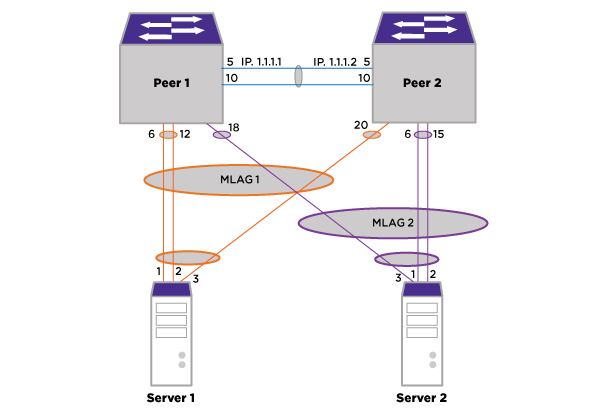Scalability Impact on Load Shared Groups
When static load sharing is used for the MLAG ports, and if there is a single link connecting the server node and the MLAG peer switches, the port does not need to be configured as a load shared port on the MLAG peer switches. Configuring LACP on MLAG ports can reduce the number of load shared ports that can be configured in the system.
Configuration Guidelines
- LACP configuration for MLAG ports (system priority, LACP timeout, activity mode, etc.) should be the same on all the MLAG peer switches.
- We recommend that the server node has a lower System Aggregation Priority than the MLAG peers so that the server node chooses which of the ports can be aggregated. As an example, there are a maximum of 8 ports that can be aggregated together, and there are eight links from Peer1 to the Server, and another eight links from Peer2 to the server node. When the server node has a lower System Aggregation Priority, it can choose which of the total available links can be aggregated together.
- If the Port Aggregation Priority is not configured for the load shared member ports, there is a chance that only the links from server node to one of the MLAG peer are aggregated together (based on the port numbers). In this instance, the links from the server node to the other MLAG peer are unused. To avoid this, you can configure the Port Aggregation Priority on the server node so that the number of active links to the MLAG peers is balanced.
- You must configure load sharing groups on all the MLAG ports even if they contain just one port.
- It is recommended to configure static LACP MAC on both MLAG peers to avoid traffic interruption during failure scenarios.
Below are sample configurations.
Configuration on Peer1
create vlan "isc" configure vlan isc tag 4000 enable sharing 5 grouping 5,10 lacp configure vlan "isc" add ports 5 tagged configure vlan "isc" ipaddress 1.1.1.1/8 create mlag peer "peer2" configure mlag peer "peer2" ipaddress 1.1.1.2 configure mlag peer "peer2" lacp-mac 00:11:22:33:44:55 enable sharing 6 grouping 6,12 lacp enable sharing 18 grouping 18 lacp enable mlag port 6 peer "peer2" id 1 enable mlag port 18 peer "peer2" id 2
Configuration on Peer2
create vlan "isc" configure vlan isc tag 4000 enable sharing 5 grouping 5,10 lacp configure vlan "isc" add ports 5 tagged configure vlan "isc" ipaddress 1.1.1.2/8 create mlag peer "peer1" configure mlag peer "peer1" ipaddress 1.1.1.1 configure mlag peer "peer1" lacp-mac 00:11:22:33:44:55 enable sharing 20 grouping 20 lacp enable sharing 6 grouping 6,15 lacp enable mlag port 20 peer "peer1" id 1 enable mlag port 6 peer "peer1" id 2
Configuration on Server Nodes (assumed to be Extreme Switches)
enable sharing 1 grouping 1,2,3 lacp configure sharing 1 lacp system-priority 100 configure lacp member-port 1 priority 10 configure lacp member-port 2 priority 20 configure lacp member-port 3 priority 15
LACP Ports in MLAG Configuration


